Affiliate links may be included for your convenience. View our privacy and affiliates policy for details.
As I have been doing more painting and mixed media type projects, I have found myself delving into art supplies I didn’t know much about before.
One of my most-needed supplies right now is a white pasty substance called gesso. Gesso is a primer that’s used for preparing canvases and other surfaces for painting. It smoothes out the surface and makes it so the paint doesn’t soak into the canvas or other substance you’re working on.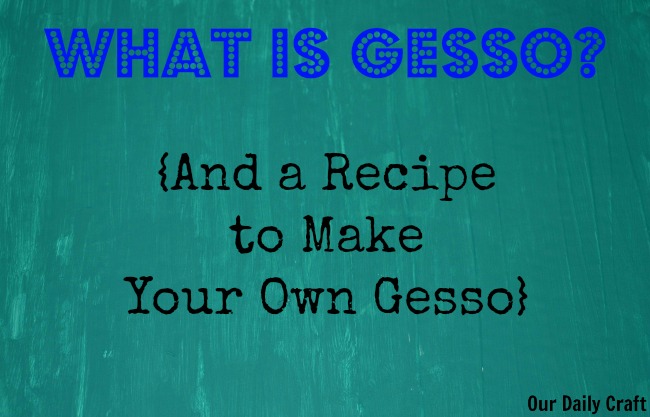
Check out more uses for gesso you might not have thought of.
It’s typically made out of calcium carbonate, acrylic polymer latex and other chemicals (often including paint for whiteness) and makes it possible to paint on all kinds of surfaces with all kinds of paints.
I use a lot of gesso because I’m painting mostly on cardboard instead of prepared canvases. The trouble is, it’s pretty expensive. I have used Pro-Art Premium Gesso Canvas Primer in the past, but I thought I’d look into the possibility of making my own gesso and see how it compared to the store-bought stuff.
Make Your Own Gesso Recipes
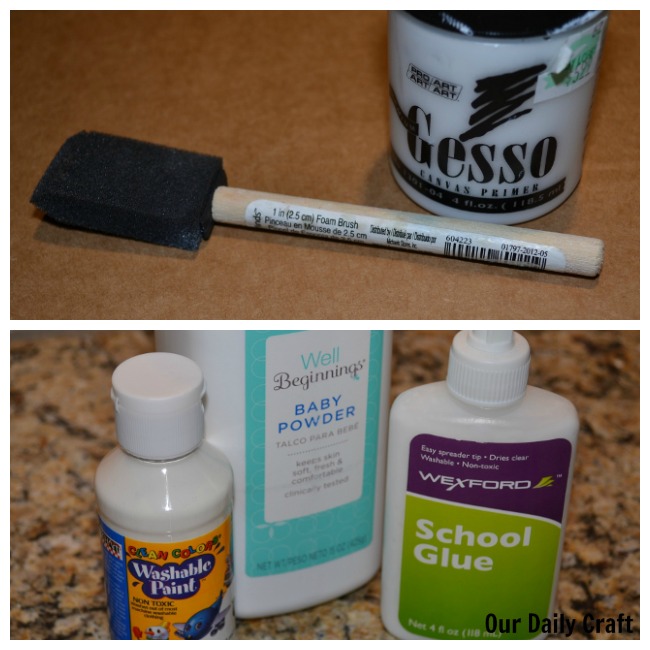
Searching around online, I found a variety of recipes. Crafting with Style has a roundup of recipes for gesso using plaster of Paris, dextrin powder and chalk and glue, for example. Pixie Dust has recipes using drywall compound and glue and baby powder and glue.
The most popular recipes I found hit on using talcum powder (or baby powder, which is talc with fragrance added) and glue, with or without the addition of paint to make it a different color if you like.
The recipe I ended up trying is from Such a Pretty Mess:
- 1/4 cup taclum powder
- 1 tablespoon white glue
- 1 tablespoon white paint
- water to desired consistency
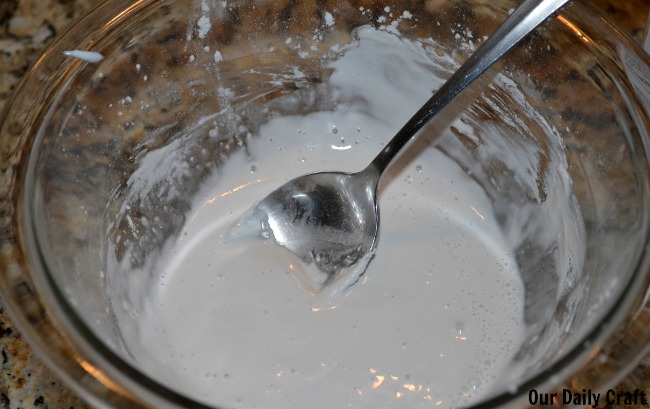
I mixed the first three ingredients and found it more solid than liquid, so I ended up adding 2 tablespoons of water to get to what I thought was something like the consistency of my store-bought gesso.
Using Homemade Gesso
I wanted a side-by-side comparison so I tried my homemade gesso along with store-bought gesso on two surfaces: a kid’s book I was converting into an art journal and a piece of cardboard.

I thought that the homemade gesso looked a lot thinner going on than the store-bought version.
But once they dried, the look was more similar. Mine isn’t as white, but that probably has to do with the cheap, washable paint I used in my formulation.
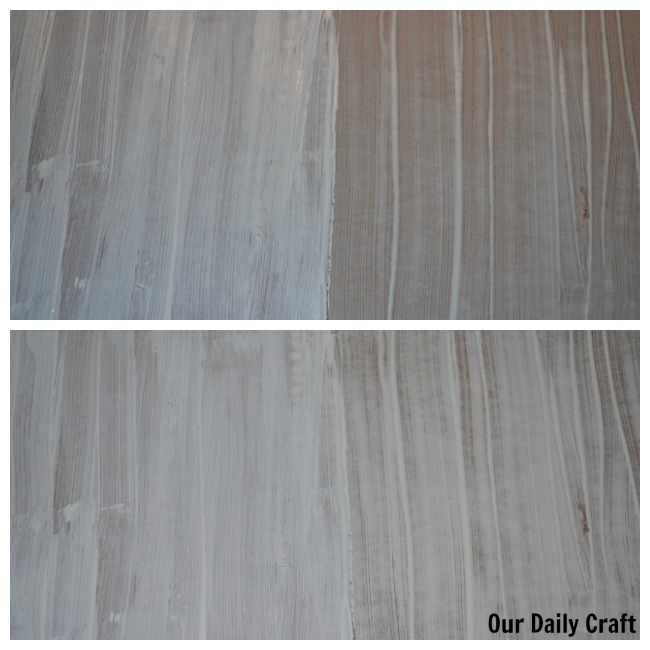
My version feels more textured, indeed more chalky, and the lines of the brush strokes (I used a foam brush) are much more pronounced. The store-bought gesso side feels smooth even as you can see strokes, but on the homemade side you can feel every bump.
I felt like it didn’t cover the book pages quite as well, but again, as it dried there was less of a difference than I thought there would be. Both are semi-translucent. I have read that more coats will cover more thoroughly, so I may end up doing a second coat (of both kinds) on the book to make it a little less see-through.
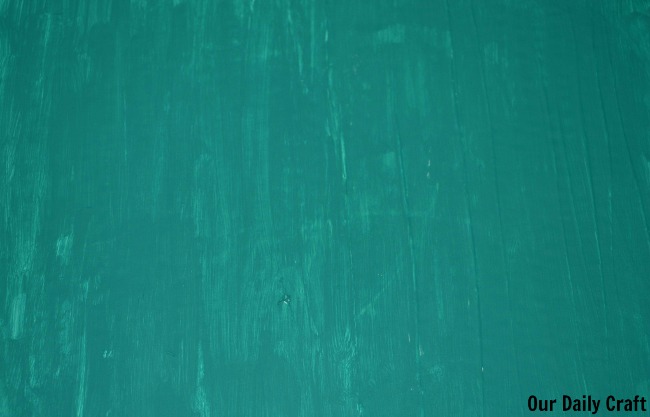
I painted my cardboard a solid color to test the gesso, and it felt like it took more paint to cover the homemade side, but that could have just been because of the added texture. (And when dry, the homemade side looks like it got more coverage, because it did.) Both sides look good, but they do look different.
Homemade Gesso Bottom Line
I haven’t used make your own gesso enough to definitively say it’s better or worse than the store bought. There are pros and cons to everything, but while I’m practicing and playing I think the homemade stuff is worth it.
It’s fun to make your own supplies, and the texture the homemade gesso adds is interesting. If I wanted a super-smooth surface, though, I’d probably thin out the homemade stuff even more or spring for the store bought.
I made gesso again and made a quick video showing how I do it and how I use it. It works great!
Do you use gesso? Have you ever made your own? I’d love to hear your thoughts.
Want more creative tips and inspiration? Sign up for my newsletter!
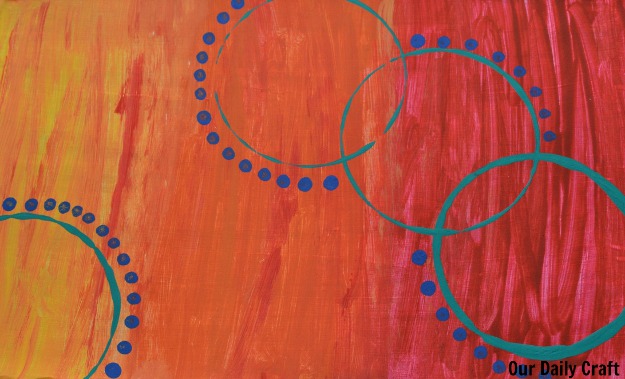
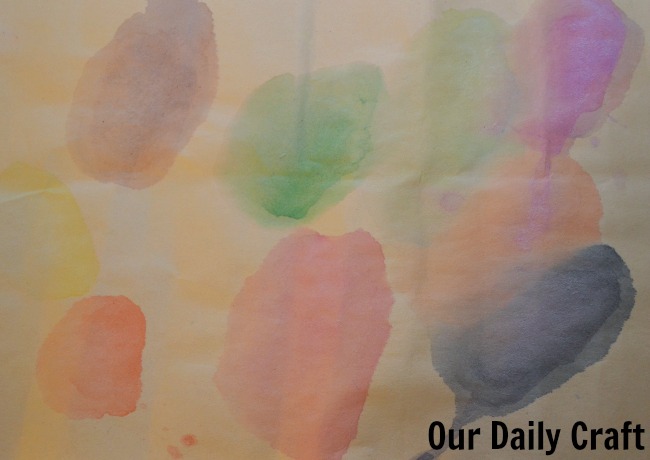
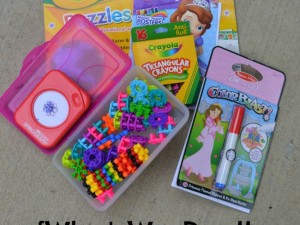
54 Comments
I’ve always wondered what gesso is but haven’t bothered to research it. Glad I clicked over! May try the homemade recipe this weekend.
I am making my own gesso pretty much the same formula, but finding the gesso is cracking, especially when the canvas is pushed from the back??
Hmm. Most of the surfaces I’ve used it on have been kind of hard (cardboard) so I haven’t had that experience. Will have to check and see.
Hi! I bought the store bought gesso and wasn’t paying attention to the description on the bottle; just looking at price and the word “gesso” 🙂
So, I just used it the other day in a mixed media journal. When it dried I was kind of disappointe. As I’d purposefully made texture, the bumps and ridges had a dried plasticy feel and look. Finally, read the bottle – acrylic gesso! Obviously, I’m not a real artist, I’m just messing around, so I THOUGHT gesso would be more chalky? I assumed gesso was gesso and since I’m buying from a big box craft store, they’d surely know more than I.
Anyway, I’m going to try and make my own, when I can. Thanks for your article! Very helpful and informative!!
I made what i thought was gesso this weekend for a journalling project im doing. i used wall paint plaster of paris and a touch of white glue. i ended up adding loads of inks and kids play paint to change the colour and actually i have come up with something i really like.
Yes, I’ve seen some recipes with plaster of Paris, too. Haven’t tried it yet but glad to hear you liked it!
I am a painter looking for a cheaper alternative to Gesso, for most painters we are using it to give our canvases a professional look (hiding staples, imperfections in the canvas including the canvas texture) and we need a product that can be sanded and that is why we are stuck using the pricey alternative. Gesso itself doesn’t quite smooth the surface, it is just a material that can be sanded until its smooth, whereas an acrylic paint on its own would peel and leave scratch marks. So after all that, my question is, can this homemade version be sanded?? 🙂 Thanks for your time and experimenting!
Thank you Sarah for posting your experience with the homemade Gesso. Have you tried to mix the Gesso in a blender, it might not be as rough….just a thought.
Oh, that’s an interesting idea, Tracie! Will have to try that some time.
I just happened to get here when I tried to search DIY Gesso. Way back in college, we used a mix of white flat latex paint , Elmer’s glue, and something called “patching compound”. Its a powdered chalk thing similar to plaster of paris, but cheaper and doesn’t harden fast when mixed with water.
I’m not sure about the measurements/parts to a gesso-like consistency. I guess it depends on your own liking. 😛
A chalky gesso would be best for sanding smooth. Plaster of Paris would be an easy choice. Calcium carbonate ,or powdered chalk, would be best. This can be found online through ceramic suppliers. Adding acrylic polymer to the white paint maybe improve film flexibility and help with cracking. I need to experiment.
Your homemade mix is what I use for texture paste. For homemade gesso you can use either a ninja blender or a mortar and grind up white tums (store brand is cheapest, or a big bottle of mint flavored from Sams Club, you could use colored ones if wanted) which IS calcium carbonate, mix with a small amount of white acrylic craft paint, water and for more smoothness a bit of white cosmetic clay mix to the consistency of a crepe batter which is tad bit runnier than pancake batter. I am not against a drop or so of regular food grade glycerin which helps it set nicely. I find it easiest to mix by finely grinding my powders then using warm water say 1/4 cup and adding 2 tablespoons ‘tum powder’ and 2 teaspoons of paint TO the water rather than the water to the powder. Just start quickly swirling the water and paint around as you pour the powders in as a last step.
Thanks for the tips, Darla! I will have to try it with Tums. 🙂
Where can I buy this gesso ?
what about the black gesso?same procedure with black color instead of white or there’s something else to it?thanks for the article though …
Hi l am a rocking horse make and l make my own gesso to give me a supper fine finish the way l make mine id to mix calcium carbonate with PVA wood glue and when dry sand with 2,000 grit paper this gives me a glass like finish
I make my gesso with calcium carbonate powder (chalk ), white glue, white wall paint & water to mix. Usually make up a batch and keep in an air tight container, like a glass jar or old plastic laundry bottle. Add alcohol inks or experiment with other acrylic colours of your choice. You can also use this on furniture etc
Has anyone figured out how to make CLEAR gesso??
I’m also very interested in preparing Clear Gesso & Black Gesso.
I used your recipe; however, I added 1/2 and 1/2 of baking soda and talcum powder. I also added a little bit of acrylic gel medium. I have covered a piece of (I guess it’s called) chipboard that I took apart out of an old 3-ring binder — it is rather thin and not very hard. It made a nice finish for the surface and so far has kept the texture patterns that I made. However, I wanted to cover an antique cookbook with the remaining “gesso”, which I thought was a little too wet, since the other surface buckled. I just added some more baking soda until it was “pastier” and covered the book with the “gesso” and my fingers to smooth it out. I am waiting for both to dry and will let you know the results. I am hoping that the acrylic gel medium will not cause a disaster…
At art school a long long time ago , we used a mixture of plaster of paris,whiting (calcium sulphate) and plastic paint in equal quantities . and I think water. This mixture was sandable, durable and has been long lasting. I have not seen it cracking. I have used it with water colour, ink,and acrylic paint. It is extremely long lasting in an airtight container. { As poor students we also mixed cornflour with acrylic paint but be careful the cockroaches loved it)I wonder if anyone knows the exact quantities used for this mixture.
Clear gesso recipe
30g whiting powder (used for marking lawns for tennis, available at some hardware stores)
166g water
208g pva glue
10g clear glaze medium
Shake up in a jar
Much more ‘invisible’ than store bought, but with plenty of tooth.
Informative writing ! BTW if others have been needing a a form , my colleagues saw a fillable document here
https://goo.gl/yaotFYRecant you just use chalk paint with a little glue? It can be sanded, it covers anything and it’s cheap.
I wonder what’s the difference between gesso and modeling paste, as both of them has the same ingredients.
I made this about a year ago and it wen on perfectly for a Carnival-type mask made of paper mache
Im doing it again to go over a paper mache sculptural piece for my art exams, i like the texture it gives and hope fully it will come out nicely once again
Very helpful as I tend to recycle canvases I buy from junk shops to save money. Some are real cotton duck cloth so only need standard primer paint. But many canvases are those ‘photographic prints’ which are vinyl in texture; no key for paint. I have been mixing wood glue, and primer then using this but it is hellish to brush on & doesn’t always give texture to the flat canvas surface. Adding chalk ….never thought of that! Brilliant! Thank you. As a vegan too, I’m aware that traditional gesso has binder from rabbit skin glue. So this is great to find home made recipes.
I have a question. I’m just starting out in mixed media canvas painting and I find myself a little confused. What is the difference between gesso and texture paste. The DIY recipes are the same, but do they serve different purposes? Thanks so much!!!
I am glad you shared this. It is very informative. Truth is I cannot find gesso here in our place. I think I have to make my own based on your suggestios.. Thank you very very much.
A few years ago I took an abstract painting class. I remember photocopying something out of a magazine. I then put gesso on it and when it dried it was kinda rubbery . Then I put it on canvas and made a painting. Do you think your home-made gesso would work?
Thanks
Sandy
Sort of like Mod Podge? This is white, though, so you wouldn’t be able to see the image you were covering that well.
Awesome thread. I’m trying to recycle some ruined canvases from gloss coat varnish which crazed and that additional varnishing did not fix (still crackled) so I decided to start from scratch with professional Liquitex gesso which I had on hand. The 1st coat didn’t help as crazing is still apparent. Still waiting for 2nd coat to dry. Since I read this thread, once 2nd coat is dry and sanded, I may try “beefing up” my next coat with some suggestions in your thread. I also have some artwork I purchased to recycle the canvases that needs a fresh start. Thanks for starting this thread, very informative. Happy creativity. Cathie
I just use acrylic undercoat from screw fix , first class results and very economical,
screwfix” s own acrylic undercoat
This is ok for school, but don’t think that you will save money by usiing this for your profesional painitngs. Read this forum thread first: http://www.wetcanvas.com/forums/showthread.php?t=1427476
I’m not a professional, so it works OK for me.
Hey I just made some five minutes ago, painted it unto my canvas, I like it, thanks. One question though, where do you store the left over, does it need to be kept in the refrigerator or room temperature?
When I saw the price of Gesso, I was shocked to find how expensive it is. I really want to make my own. My question is you listed white paint as one of the ingredients, I’m guessing you mean acrylic white paint?
Many years and I do mean this, I purchased a container of Gesso I do not remember the brand, but it was a major brand co, it was kind of thick, I never used Gesso before and didn’t know what it was used for. This is before people had computers. Anyway I used it with a pallet knife and put it on planter pots- not the plastic kind. I textured it on. Do not remember if I added acrylic paint to it or if i painted it after the gesso dried. It dried kind of plastic like with a high sheen and could be washed.
I recently bought a large container of gesso only to find I bought a thin gesso. I do not remember the original gesso to say it was thick or anything else but gesso.
Does anyone know if what I originally bought is still on the market and what it is called.
Any way to make kind of the original gesso that is thick and dries like kind of plastic and very shinny using my thin gesso or not. It made beautiful planter pots. Thanks
Having just completed a night-class in mixed media, and being on a severely limited income, I’m keen to find inexpensive alternatives to store-bought materials. I’m painting on (treated) pine off-cuts sourced from my landlord (a building contractor), and using the cheapest gesso I can find. Like several other posters, I was given a recipe for modelling medium which is identical to this recipe for gesso, but with twice the amount of talc. But it cracks like anything when dry (ugh!). I may try it for gesso when my current pot runs low… My tutor told us gesso is made with marble dust (!). Chalk dust sounds good; blackboard chalk is inexpensive. The modelling medium I’ve made is keeping well in an airtight jar at room temperature
I’ve been first using PVA glue watered half and half first to seal the canvas or linen and then apply bought Gesso on top. Seems okay and also saves on the Gesso. PVA glue is cheap and wonderfully effective.
Also as an aside I paint in oil and discovered that Vanish soap works really well for cleaning brushes!!!
I am new to oil painting and really painting in general I haven’t did any painting in quite some time. Growing up with my father being a professional painter. A generally used multimedia and even though he has some terrific oil paintings and he started out using oil paint he prefers watercolor more than any of them nowadays and some of his paintings are truly very skilled to say the least. I’ve always been more of a pencil sketch kind of artist and pen and ink art has been one of my main focuses throughout the years. We never really discussed a lot about painting over the years due to him taking a break or my lack of interest in painting at the time being but now since we’re both into painting and we’re on the same page he is providing me with some useful tips. I have yet to still and use gesso. I have some oil paints and some mineral spirits and some pallets and a ton of really good brushes and canvases and canvas board and I’m going to try the recipe that I read about here in this article and I will let you know how it goes I’m going to try to mix the baby powder with glue and a little bit of washable paint and using the same ratios mentioned above we will see how it turns out. Thank you for all your support and help.
I’ve read through your comments and they talk about gesso being thin like pancake batter. I’m new to all this so I thought I’d start out with the real stuff; but the acrylic gesso I bought is thicker, more like a soft toothpaste. So I’m confused, why is my store bought thicker?
You are genius, thanks for sharing your experience.
I’m going to try it now?
PVA Glue can be purchased from Screwfix or B&Q in Large quantities. I have dyed it with Acrylic Paint.
Then applied it with a roller.
Hello
I am abiggener of oil painting.I can paint on every card board which is hard to paint.I have no idea that there is a gesso can be used to make my card smooth and esy to use in painring.it is really helpful for me.thanks
This proves you can learn something new everyday. I never even knew what “gesso” was and had to visit your article to find out. Thanks for the info!
I am an older guy and new to art painting. I bought some “Golden” brand Gesso today and applied it to a canvas. My first thought was “What is the difference – if any – between this and sheetrock primer”? Both of fairly high in solids…. Any thoughts on this?
Hi sara , thank you so much to share a detailed explanation about gesso. Dear i want to know
is it compulsary to use white colour paint in the recipe ?
And can i use white oil paint instead of acrylic or other type of paint?
What is the purpose of the glue? Is it for thickness or ease of sanding maybe?
Thanks for sharing!!
I found this YouTube video for making gesso. It’s calcium carbonate, glue, and paint. I just bought the calcium and glue on Amazon. Glue was in a gallon container and calcium was a 5lb bag. I’ll be mixing it up later today. The quality of products will really make a difference. I’ll be able to make well over a gallon with the little that I bought.
https://youtu.be/Rtd3AFGA-0o
Tonight i got really crazy and mixed bentonite clay, white acrylic paint, wood glue and aloe vera gel. I’m interested in making gesso with as few toxic ingredients as possible. Also same with paint- but will use up tubes of acrylic first. thanks everyone for ideas.
I’ve been playing around with making my own using Diatomaceous Earth, Elmers glue and a acrylic medium. Works great, its flexible and sandable. also the Diatomaceous Earth is a bug killer and it is eatable! Yes you can eat it and not get sick even though you find it in the garden dept. with bug killers.
I commend you for trying to make your own gesso. I’m a professional artist, and even I will sometimes attempt a different approach into sort of reinventing the wheel. However, as my wife quietly reminds me, “Why don’t you just go purchase what you need rather than trying to make something that may not provide you with the professional results you desire.” Over the course of a long and happy marriage, I have learned to listen to her advise. So, while I appreciate your gesso efforts, I include the following: Typical gesso is applied to a surface in order to provide something to which a paint may adhere. Calcium carbonate (ground limestone) combined with finely ground marble provides this rough texture. TALC provides a slick particle and that’s why it is used in baby powder. You used white glue- a good choice. Your glue is the binder, very similar to PVA glue and it works. Use too much glue and your gesso ends up drying to a slick surface not suitable for paint to adhere. Too little glue, and your gesso will revert back to powder. White pigment (most often titanium dioxide in correct proportions) is ok. I sometimes add white paint pigment to my gesso (maximum of 2 oz. per gal.) Washable paint isn’t so great as it has minimum pigment and minimal binder.
Gesso goes on relatively translucent, and several coats are often required. Thus your almost clear result is normal EXCEPT, using talc, you have not created a substantially rough surface to which your paint will adhere. NOTE: Commercial gesso is made in many grades and from its appearance, I suspect the grade you compared is one of the least expensive formulas. Thus I conclude that YES, you can make your own gesso and be successful, but please do a little component research and purchase “archival quality”. Baby Powder is for Babies.
I use versante chalk paint. Mixed with water or plain. Depending on the cover you want. It can be sanded, comes in loads of c olours, covers anything and has not let me down.